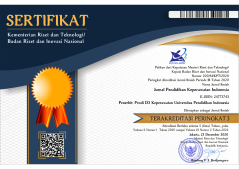Attitude Towards E-Learning Among Nurses in Continuing Education
Abstract
The rapid development of technology encourages learning methods that are more practical, efficient, and fast. E-learning is believed to be an effective learning method for nurses in the hospital environment. The e-learning module requires adequate facilities and positive learner characteristics. Understanding nurses' needs and learning perspectives will facilitate e-learning implementation, especially for continuing nursing education. This study aimed to analyze the relationship between experiences and the importance of e-learning, barriers, motivation, and nurses' attitudes towards the e-learning method in a private hospital. This study applied a quantitative method with a correlation design and conducted a purposive sampling technique with 66 samples. This study used an attitude questionnaire towards e-learning which was adapted from Chong. This study revealed that most of the nurses already had experienced e-learning (98.5%). In addition, half of the nurses had positive attitudes towards e-learning (53%), almost two-thirds of nurses were motivated (74.2%), more than half perceived that e-learning is less critical (51.5%), and nurses reported a few obstacles to participating in e-learning (57.6%). Moreover, there was no significant relationship between experience, barriers, motivation, the importance of e-learning, and nurses' attitudes towards e-learning (p value> 0.05). On the other hand, nurses also reported the main barriers to participating in e-learning included lack of time and minimum computer access to the internet (> 70%). It is noted that nurses have the motivation to continue learning in the scope of clinical practice using e-learning. Only some nurses show a positive attitude towards e-learning. Thus, some improvements are needed to support e-learning for nurses, such as more time for learning, additional knowledge about computer use, and adequate internet networking
Keywords
References
Boniol, M., McIsaac, M., Xu, L., Wuliji, T., Diallo, K., & Campbell, J. (2019). WHO | Gender equity in the health workforce: Analysis of 104 countries. World Health Organization, (March), 1–8.
Butarbutar, F. T. S., & Haryanto, Y. (2017). Kajian Signifikansi Faktor Yang Mempengaruhi Penggunaan e-Learning Pada Siswa SMK Global Informatika Tangerang. Jurnal RESTI (Rekayasa Sistem Dan Teknologi Informasi), 1(1), 9-18.
Chong, M. C., Francis, K., Cooper, S., Abdullah, K. L., Hmwe, N. T. T., & Sohod, S. (2016). Access to, interest in and attitude toward e-learning for continuous education among Malaysian nurses. Nurse Education Today, (January), 370-374.
Chuo, Y. H., Tsai, C. H., & Lan, Y. L. (2011). The effect of organizational support and self efficacy on the usage intention of E-Learning system in hospital. Key Engineering Materials, 467, 2137-2142.
Emaliyawati, E., Widiasih, R., Sutini, T., Ermiati, E., & Rahayu, U. (2020). Nurses’ Reflections on Challenges and Barriers of Communication in the Intensive Care Unit: A Phenomenology Study. Jurnal Keperawatan Padjadjaran, 8(1), 65–73.
Hanum, N. S. (2013). Keefetifan e-learning sebagai media pembelajaran (studi evaluasi model pembelajaran e-learning SMK Telkom Sandhy Putra Purwokerto). Jurnal Pendidikan Vokasi, 3(1), 90-102.
Karaman, S. (2011). Nurses’ perceptions of online continuing education. BMC Medical Education, 11, 1-6.
Kuriplachová, G., Kováčková, G., Magurová, Ld., L’udmila, M., & Kendrová, L. (2019). Advantages and Disadvantages of E-learning in Nursing Teaching. Journal of Health Systems and Policies, 1(2), 45–54.
Lahti, M., Hätönen, H., & Välimäki, M. (2014). Impact of e-learning on nurses’ and student nurses knowledge, skills, and satisfaction: A systematic review and meta-analysis. International Journal of Nursing Studies, 51(1), 136-149.
Lera, M., Taxtsoglou, K., Iliadis, C., Frantzana, A., & Kourkouta, L. (2019). Continuing Distance Education in Nursing. EAS Journal of Nursing and Midwifery, 1(5), 155–160.
Rouleau, G., Gagnon, M. P., Côté, J., Payne-Gagnon, J., Hudson, E., Dubois, C. A., & Bouix-Picasso, J. (2019). Effects of e-learning in a continuing education context on nursing care: Systematic review of systematic qualitative, quantitative, and mixed-studies reviews. Journal of Medical Internet Research, 21(10), 1-19.
Sari, I. P., & Sundari, S. (2019). Penerapan Video Pembelajaran dapat Meningkatkan Keterampilan Klinis dalam Pendidikan Keperawatan: A Literature Review. Jurnal Pendidikan Keperawatan Indonesia, 5(1), 34-41.
Subu, M. A., Ismail, R., Dias, J. M., Abraham, M. S., Waluyo, I., Maryuni, M., … Soemarno, S. (2020). An Investigation of the Interests and Reasons of Diploma Nurses Undertake a RN-BSN Bridging Program in United Arab Emirates. Jurnal Keperawatan Padjadjaran, 8(2), 151-165.
Wilson, A. (2018). The Impact of Online Video Learning Activities on Nurses’ and Midwives’ Continuing Professional Education. COJ Nursing & Healthcare, 2(2), 1–7.
DOI: https://doi.org/10.17509/jpki.v7i1.29007
Refbacks
- There are currently no refbacks.
Jurnal Pendidikan Keperawatan Indonesia(JPKI) published by Indonesia University of Education. JPKI is licensed under a Creative Commons Attribution-ShareAlike 4.0 International License.
Office :
Nursing Department. FPOK UPI.
229, Dr. Setiabudhi Street. Bandung 40154
West Java , Indonesia
E-mail : jpki@upi.edu

_.png)
_.png)
_.png)











